Determination of Aminoglycosides by Ion-Pair Liquid Chromatography with UV Detection: Application to Pharmaceutical Formulations and Human Serum Samples
Abstract
:1. Introduction
2. Results and Discussion
2.1. Study of the Separation of Aminoglycoside Antibiotics by HILIC
2.2. Study of the Separation of Aminoglycoside Antibiotics by IP-LC
2.3. Validation of the Optimized IP-LC-UV Procedure
2.4. Analysis of Pharmaceutical Formulations
2.5. Application to the Analysis of Serum Samples
3. Materials and Methods
3.1. Chemicals and Reagents
3.2. LC System and Chromatographic Conditions
3.3. Validation of the IP-LC-UV Method
3.4. Analysis of Pharmaceutical Formulations
3.5. Analysis of Streptomycin (STR) and Dihydrostreptomycin (DHS) in Serum Samples
4. Conclusions
Author Contributions
Funding
Institutional Review Board Statement
Informed Consent Statement
Data Availability Statement
Conflicts of Interest
References
- Glinka, M.; Wojnowski, W.; Wasik, A. Determination of aminoglycoside antibiotics: Current status and future trends. Trends Anal. Chem. 2020, 131, 116034. [Google Scholar] [CrossRef]
- Yadav, R.; Bulitta, J.B.; Schneider, E.K.; Shin, B.S.; Velkov, T.; Nation, R.L.; Landersdorfer, C.B. Aminoglycoside concentrations required for synergy with carbapenems against pseudomonas aeruginosa determined via mechanistic studies and modeling. Antimicrob. Agents Chemother. 2017, 61, 12. [Google Scholar] [CrossRef] [PubMed]
- Hoefsloot, W.; van Ingen, J.; Andrejak, C.; Angeby, K.; Bauriaud, R.; Bemer, P.; van Soolingen, D. The geographic diversity of nontuberculous mycobacteria isolated from pulmonary samples: An NTM-NET collaborative study. Eur. Respir. J. 2013, 42, 1604–1613. [Google Scholar] [CrossRef] [PubMed]
- Cegielski, J.P.; Chan, P.C.; Lan, Z.; Udwadia, Z.F.; Viiklepp, P.; Yim, J.J.; Menzies, D. Aminoglycosides and capreomycin in the treatment of multidrug-resistant tuberculosis: Individual patient data meta-analysis of 12 030 patients from 25 countries, 2009–2016. Clin. Infect. Dis. 2021, 73, 3929–3936. [Google Scholar] [CrossRef]
- Tzovaras, V.; Tsimihodimos, V.; Kostara, C.; Mitrogianni, Z.; Elisaf, M. Aminoglycoside-induced nephrotoxicity studied by proton magnetic resonance spectroscopy of urine. Nephrol. Dial. Transplant. 2011, 26, 3219–3224. [Google Scholar] [CrossRef]
- Singh, H.; Richu Bandral, R.; Majid, Q.; Kumar, A. Investigation of molecular interactions of streptomycin sulphate with aqueous L-aspartic acid through volumetric, ultrasonic and viscometric approach. J. Mol. Liq. 2023, 382, 121885. [Google Scholar] [CrossRef]
- He, Q.; Yao, K.; Jia, D.; Fan, H.; Liao, H.; Shi, B. Determination of total catechins in tea extracts by HPLC and spectrophotometry. Nat. Prod. Res. 2009, 23, 93–100. [Google Scholar] [CrossRef]
- Perić, M.; Savanović, M.M.; Bilić, A.; Armaković, S.J.; Armaković, S. Comparative analysis and validation of analytical techniques for quantification active component in pharmaceuticals: Green approach. J. Indian Chem. Soc. 2024, 101, 101173. [Google Scholar] [CrossRef]
- Kumar, P.; Rubies, A.; Companyó, R.; Centrich, F. Hydrophilic interaction chromatography for the analysis of aminoglycosides. J. Sep. Sci. 2012, 35, 498–504. [Google Scholar] [CrossRef] [PubMed]
- Fujii, Y.; Kaga, T.; Nishimura, K. Simultaneous determination of aminoglycoside residues in livestock and fishery products by phenylboronic acid solid-phase extraction and liquid chromatography–tandem mass spectrometry. Anal. Sci. 2019, 35, 961–966. [Google Scholar] [CrossRef]
- Farouk, F.; Azzazy, H.M.E.; Niessen, W.M.A. Challenges in the determination of aminoglycosides antibiotics, A review. Anal. Chim. Acta 2015, 890, 21–43. [Google Scholar] [CrossRef]
- Zhang, X.; Wang, J.; Wu, Q.; Li, L.; Wang, Y.; Yang, H. Determination of Kanamycin by High Performance Liquid Chromatography. Molecules 2019, 24, 1902. [Google Scholar] [CrossRef]
- Bohm, D.A.; Stachel, C.S.; Gowik, P. Confirmatory method for the determination of streptomycin and dihydrostreptomycin in honey by LC–MS/MS. Food Addit. Contam. Part A 2012, 29, 189–196. [Google Scholar] [CrossRef]
- Chen, L.; Mei, M.; Huang, X. Development of multiple monolithic fiber solid phase microextraction and liquid chromatography-tandem mass spectrometry method for the sensitive monitoring of aminoglycosides in honey and milk samples. J. Sep. Sci. 2017, 40, 4203–4212. [Google Scholar] [CrossRef]
- Dasenaki, M.E.; Michali, C.S.; Thomaidis, N.S. Analysis of 76 veterinary pharmaceuticals from 13 classes including aminoglycosides in bovine muscle by hydrophilic interaction liquid chromatography–tandem mass spectrometry. J. Chromatogr. A 2016, 1452, 67–80. [Google Scholar] [CrossRef]
- Saluti, G.; Diamanti, I.; Giusepponi, D.; Pucciarini, L.; Rossi, R.; Moretti, S.; Sardella, R.; Galarini, R. Simultaneous determination of aminoglycosides and colistins in food. Food Chem. 2018, 266, 9–16. [Google Scholar] [CrossRef]
- Ianni, F.; Pucciarini, L.; Carotti, A.; Saluti, G.; Moretti, S.; Ferrone, V.; Sardella, R.; Galarini, R.; Natalini, B. Hydrophilic interaction liquid chromatography of aminoglycoside antibiotics with a diol-type stationary phase. Anal. Chim. Acta 2018, 1044, 174–180. [Google Scholar] [CrossRef]
- Zhang, Z.; Cao, X.; Zhang, Z.; Yin, J.; Wang, D.; Xu, Y.; Zheng, W.; Li, X.; Zhang, Q.; Liu, L. Synthesis of dummy-template molecularly imprinted polymer adsorbents for solid phase extraction of aminoglycosides antibiotics from environmental water samples. Talanta 2020, 208, 120385. [Google Scholar] [CrossRef]
- Díez, C.; Guillarme, D.; Staub Spörri, A.; Cognard, E.; Ortelli, D.; Edder, P.; Rudaz, S. Aminoglycoside analysis in food of animal origin with a zwitterionic stationary phase and liquid chromatography—Tandem mass spectrometry. Anal. Chim. Acta 2012, 882, 127–139. [Google Scholar] [CrossRef]
- Asakawa, D.; Uemura, M.; Sakiyama, T.; Yamano, T. Sensitivity enhancement of aminoglycosides in hydrophilic interaction liquid chromatography with tandem mass spectrometry by post-column addition of trace sodium acetate in methanol. Food Addit. Contam. Part A 2017, 35, 1116–1126. [Google Scholar] [CrossRef]
- Yang, B.; Wang, L.; Luo, C.; Wang, X.; Sun, C. Simultaneous determination of 11 aminoglycoside residues in honey, milk, and pork by liquid chromatography with tandem mass spectrometry and molecularly imprinted polymer solid phase extraction. J. AOAC Int. 2017, 100, 1869–1878. [Google Scholar] [CrossRef]
- Qiu, J.; Liu, Q.; Zhang, M.; Li, X.; Zhang, J.; Xiong, R.; He, L. Simultaneous determination of aminoglycoside residues in environmental water matrices by lyophilization combined with liquid chromatography–tandem mass spectrometry (LC-MS/MS). Anal. Lett. 2020, 53, 2235–2251. [Google Scholar] [CrossRef]
- Junlu, B.; Pengfei, H.; Junjie, Z.; Xiaojun, Z.; Yi, F.; Peipei, L. Residue analysis of 10 aminoglycoside antibiotics in aquatic products by multiwalled carbon nanotubes combined with mixed-mode ion exchange liquid chromatography-tandem mass spectrometry. J. Sep. Sci. 2023, 46, 2300118. [Google Scholar] [CrossRef]
- Arsand, J.B.; Jank, L.; Martins, M.T.; Barcellos Hoff, R.; Barreto, F.; Pizzolato, T.M.; Sirtori, C. Determination of aminoglycoside residues in milk and muscle based on a simple and fast extraction procedure followed by liquid chromatography coupled to tandem mass spectrometry and time of flight mass spectrometry. Talanta 2016, 154, 38–45. [Google Scholar] [CrossRef]
- Wang, X.; Yang, S.; Li, Y.; Zhang, J.; Jin, Y.; Zhao, W.; Zhang, Y.; Huang, J.; Wang, P.; Wu, C. Optimization and application of parallel solid-phase extraction coupled with ultra-high performance liquid chromatography–tandem mass spectrometry for the determination of 11 aminoglycoside residues in honey and royal jelly. J. Chromatogr. A 2018, 1542, 28–36. [Google Scholar] [CrossRef]
- Jariwala, F.B.; Hibbs, J.A.; Zhuk, I.; Sukhishvili, S.A.; Attygalle, A.B. Rapid determination of aminoglycosides in pharmaceutical preparations by electrospray ionization mass spectrometry. J. Anal. Sci. Technol. 2020, 11, 2. [Google Scholar] [CrossRef]
- Guironnet, A.; Sanchez-Cid, C.; Vogel, T.M.; Wiest, L.; Vulliet, E. Aminoglycosides analysis optimization using ion pairing liquid chromatography coupled to tandem mass spectrometry and application on wastewater samples. J. Chromatogr. A 2021, 1651, 462133. [Google Scholar] [CrossRef]
- Chitta, K.R.; Van Meter, D.S.; Stalcup, A.M. Separation of peptides by HPLC using a surface-confined ionic liquid stationary phase. Anal. Bioanal. Chem. 2010, 396, 775–781. [Google Scholar] [CrossRef]
- Chang, X.J.; Peng, J.D.; Liu, S.P. A simple and rapid high performance liquid chromatographic method with fluorescence detection for the estimation of amikacin in plasma-application to preclinical pharmacokinetics. J. Chin. Chem. Soc. 2010, 57, 34–39. [Google Scholar] [CrossRef]
- Feng, C.H.; Lin, S.J.; Wu, H.L.; Chen, S.H. Trace analysis of tobramycin in human plasma by derivatization and high-performance liquid chromatography with ultraviolet detection. J. Chromatogr. B 2002, 780, 349–354. [Google Scholar] [CrossRef]
- Maheshwari, M.L.; Memon, N.; Memon, A.A.; Khuhawar, M.Y.; Memon, A.H. A rapid HPLC–DAD method for quantification of amikacin in pharmaceuticals and biological samples using pre-column derivatization with Hantzsch reagent. J. Iran. Chem. Soc. 2021, 18, 611–620. [Google Scholar] [CrossRef]
- Flurer, C.L. The analysis of aminoglycosides by capillary electrophoresis. J. Pharm. Biomed. Anal. 1995, 13, 809–816. [Google Scholar] [CrossRef] [PubMed]
- Blanchaert, B.; Poderós Jorge, E.; Jankovics, P.; Adams, E.; Van Schepdael, E. Assay of kanamycin A by HPLC with direct UV detection. Chromatographia 2013, 76, 1505–1512. [Google Scholar] [CrossRef]
- Blanchaert, B.; Huang, S.; Wach, K.; Adams, E.; Van Schepdael, E. Assay development for aminoglycosides by HPLC with direct UV detection. J. Chrom. Sci. 2017, 55, 197–204. [Google Scholar] [CrossRef]
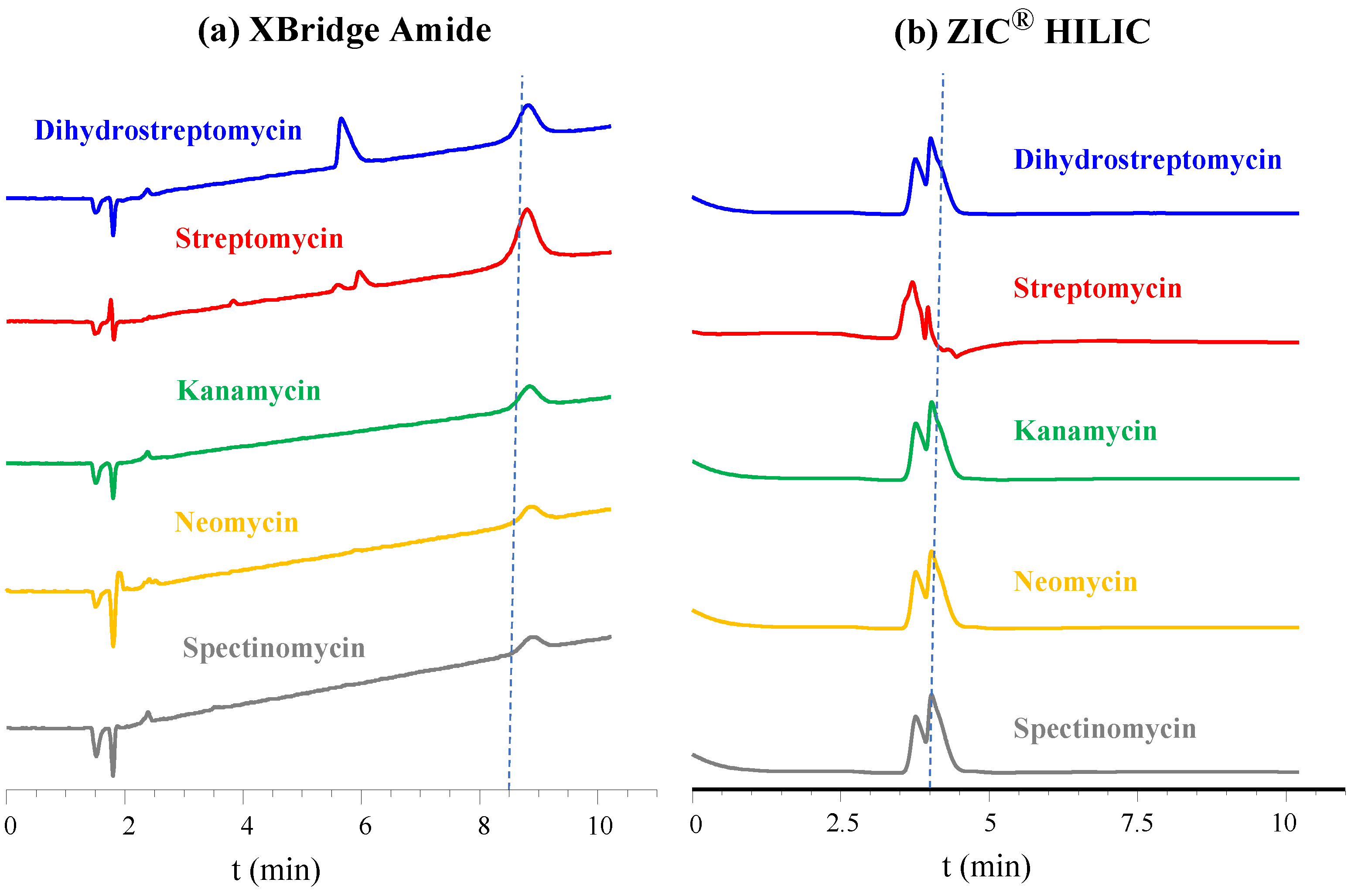
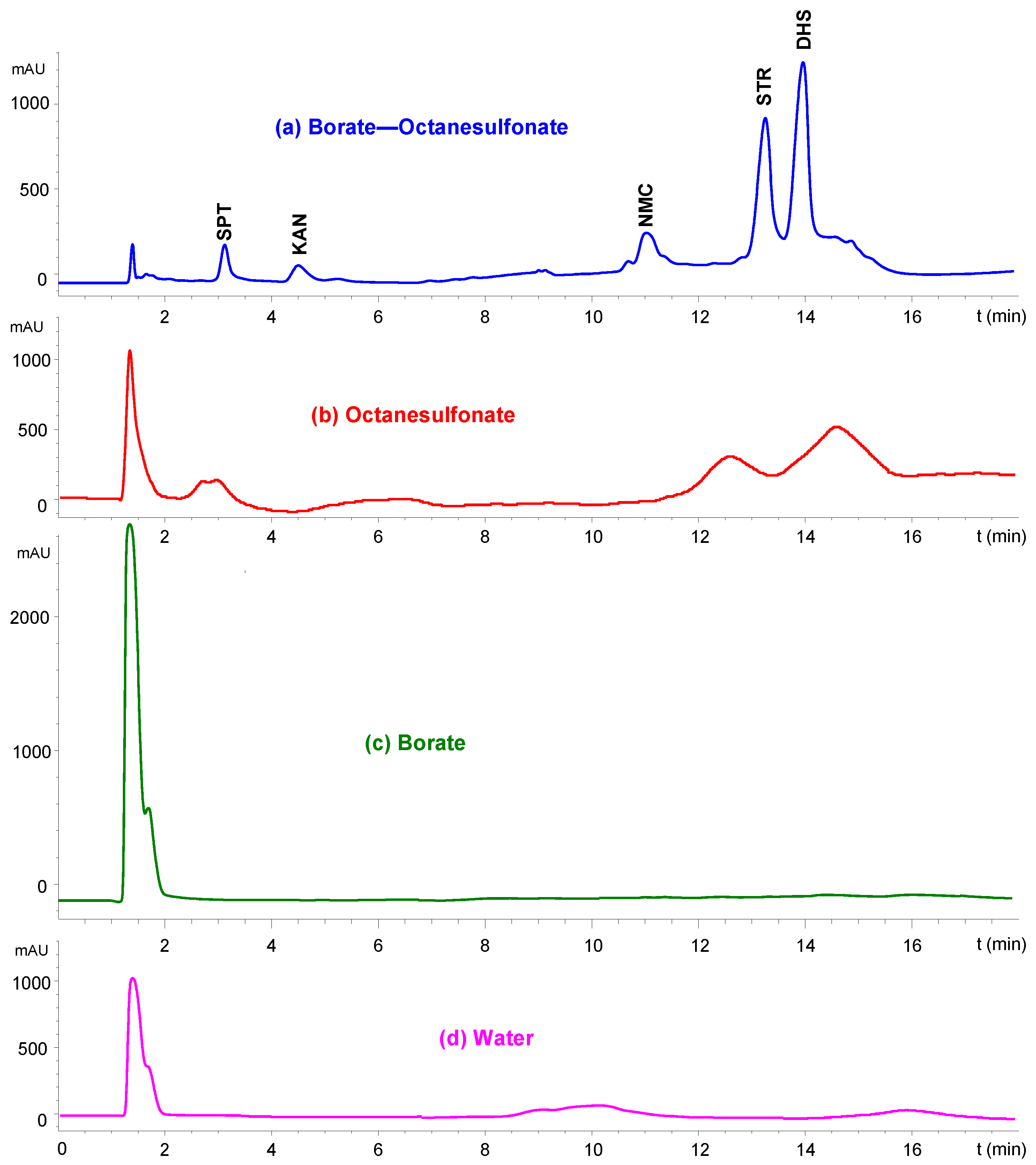

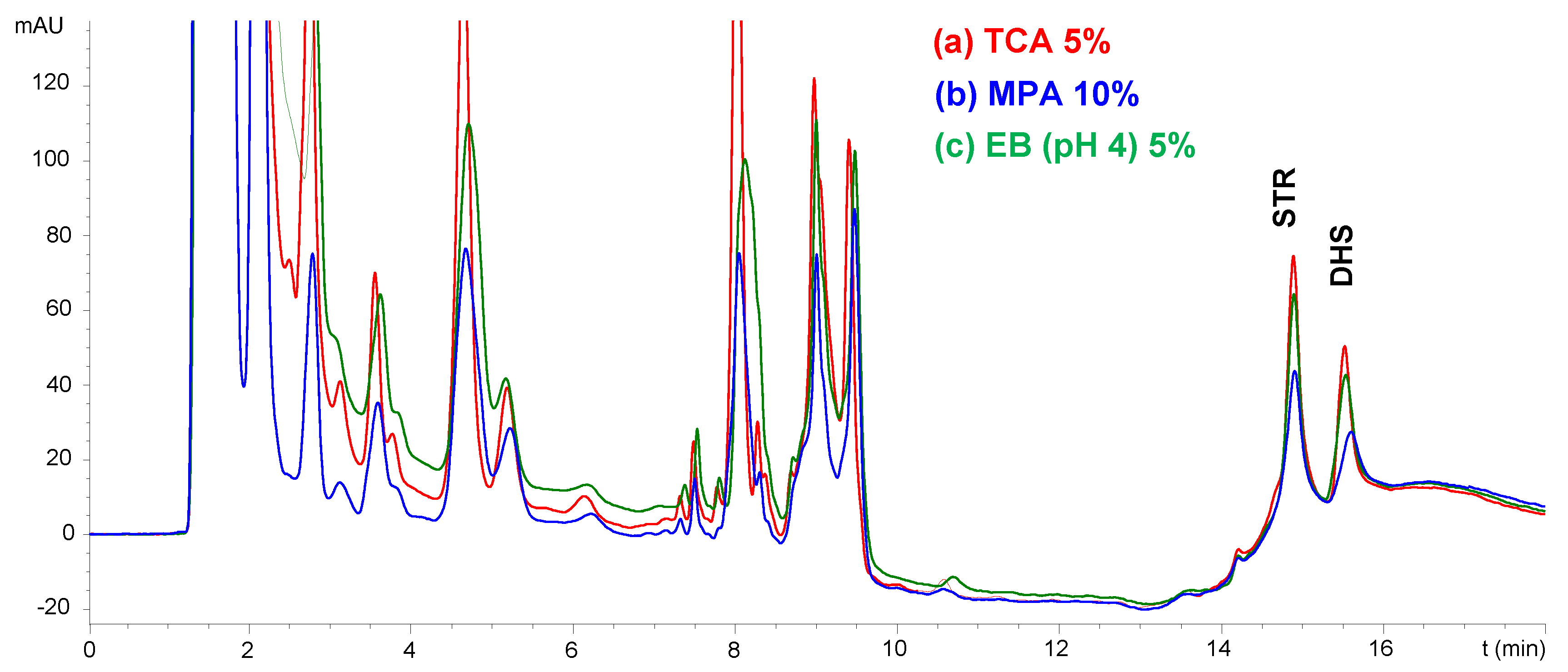
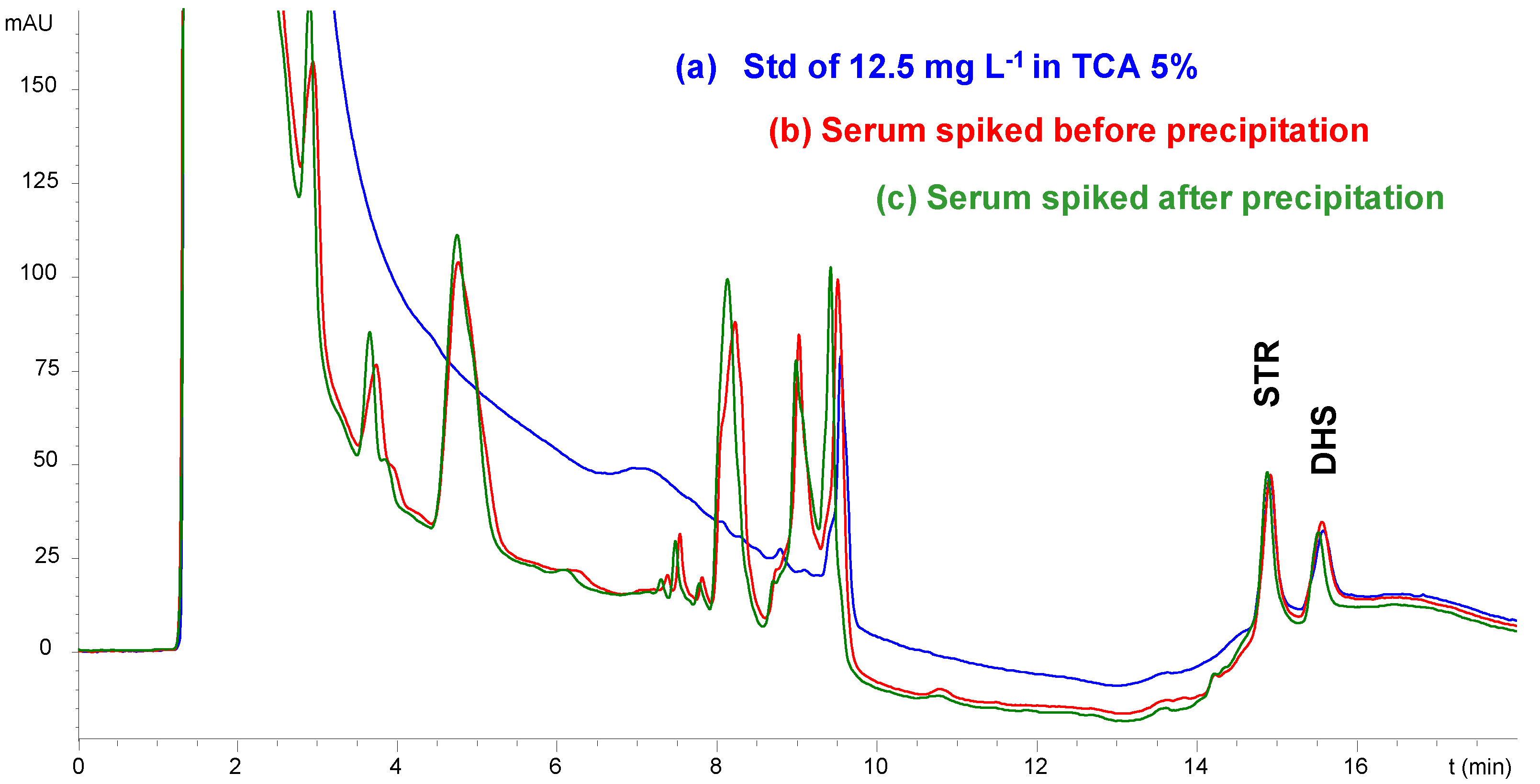
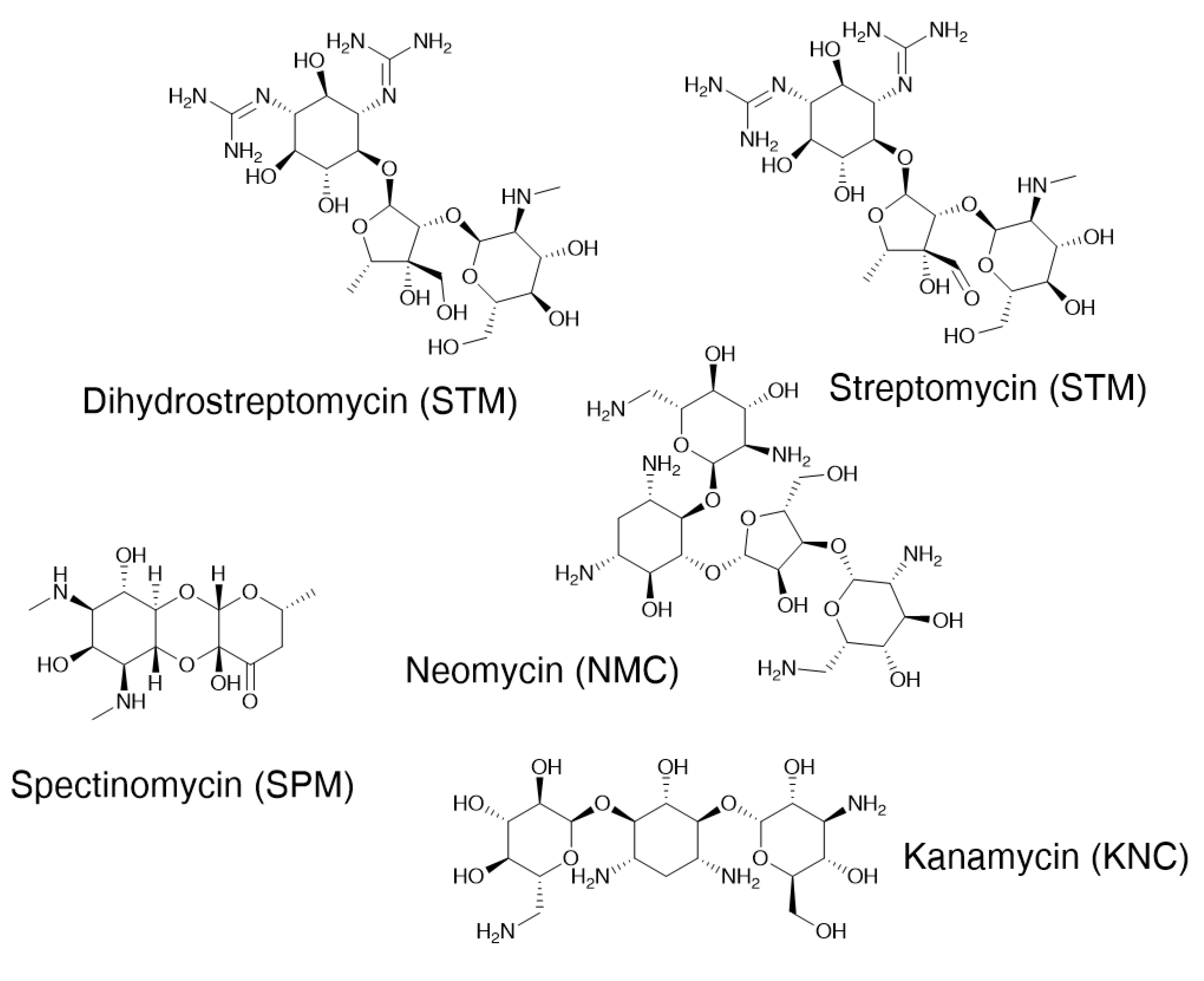
| SPM | KNC | NMC | STM | DHS | |
|---|---|---|---|---|---|
| Slope ± SD | 2.6 ± 0.1 | 2.1 ± 0.1 | 6.4 ± 0.5 | 12.0 ± 0.8 | 21.1 ± 0.3 |
| Intercept SD | 36 ± 42 | 11 ± 58 | 43 ± 61 | 28 ± 42 | 40 ± 63 |
| r2 | 0.999 | 0.996 | 0.991 | 0.992 | 0.999 |
| LOD (mg L−1) | 40 | 37 | 64 | 6 | 3 |
| LOQ (mg L−1) | 128 | 107 | 192 | 21 | 14 |
| Repeatability (%) (LOQ) | 5.0 | 8.6 | 9.9 | 8.0 | 1.5 |
| Repeatability (%) (1000 mg L−1) | 3.5 | 2.7 | 2.3 | 1.2 | 0.9 |
| Reproducibility (%) (LOQ) | 14.6 | 12.1 | 9.8 | 17.2 | 10.2 |
| Reproducibility (%) (1000 mg L−1) | 5.9 | 3.5 | 1.8 | 6.8 | 1.9 |
| Pharmaceutical Formulation | Analyte | Labelled | Added | Found | Recovered (%) |
|---|---|---|---|---|---|
| Streptomycine (sulphate) Generic | STR | 1 g | 0 | 0.982 ± 0.005 | 98 |
| 0.100 g | 1.103 ± 0.005 | 100 | |||
| 0.250 g | 1.260 ± 0.006 | 101 | |||
| Sulfintestin Neomycine® | DHS | 39 mg/tablet | 0 | 41.5 ± 0.2 | 106 |
| 3.9 mg | 42.6 ± 0.2 | 99 | |||
| 9.7 mg | 48.9 ± 0.2 | 100 | |||
| NMC | 21 mg/tablet | 0 | 19.5 ± 0.1 | 93 | |
| 2.1 mg | 22.8 ± 0.2 | 98 | |||
| 5.6 mg | 26.0 ± 0.2 | 99 |
Disclaimer/Publisher’s Note: The statements, opinions and data contained in all publications are solely those of the individual author(s) and contributor(s) and not of MDPI and/or the editor(s). MDPI and/or the editor(s) disclaim responsibility for any injury to people or property resulting from any ideas, methods, instructions or products referred to in the content. |
© 2024 by the authors. Licensee MDPI, Basel, Switzerland. This article is an open access article distributed under the terms and conditions of the Creative Commons Attribution (CC BY) license (https://creativecommons.org/licenses/by/4.0/).
Share and Cite
Herrero-Hernández, E.; García-Gómez, D.; Ramírez Pérez, I.; Rodríguez-Gonzalo, E.; Pérez Pavón, J.L. Determination of Aminoglycosides by Ion-Pair Liquid Chromatography with UV Detection: Application to Pharmaceutical Formulations and Human Serum Samples. Molecules 2024, 29, 3210. https://doi.org/10.3390/molecules29133210
Herrero-Hernández E, García-Gómez D, Ramírez Pérez I, Rodríguez-Gonzalo E, Pérez Pavón JL. Determination of Aminoglycosides by Ion-Pair Liquid Chromatography with UV Detection: Application to Pharmaceutical Formulations and Human Serum Samples. Molecules. 2024; 29(13):3210. https://doi.org/10.3390/molecules29133210
Chicago/Turabian StyleHerrero-Hernández, Eliseo, Diego García-Gómez, Irene Ramírez Pérez, Encarnación Rodríguez-Gonzalo, and José Luis Pérez Pavón. 2024. "Determination of Aminoglycosides by Ion-Pair Liquid Chromatography with UV Detection: Application to Pharmaceutical Formulations and Human Serum Samples" Molecules 29, no. 13: 3210. https://doi.org/10.3390/molecules29133210
APA StyleHerrero-Hernández, E., García-Gómez, D., Ramírez Pérez, I., Rodríguez-Gonzalo, E., & Pérez Pavón, J. L. (2024). Determination of Aminoglycosides by Ion-Pair Liquid Chromatography with UV Detection: Application to Pharmaceutical Formulations and Human Serum Samples. Molecules, 29(13), 3210. https://doi.org/10.3390/molecules29133210








